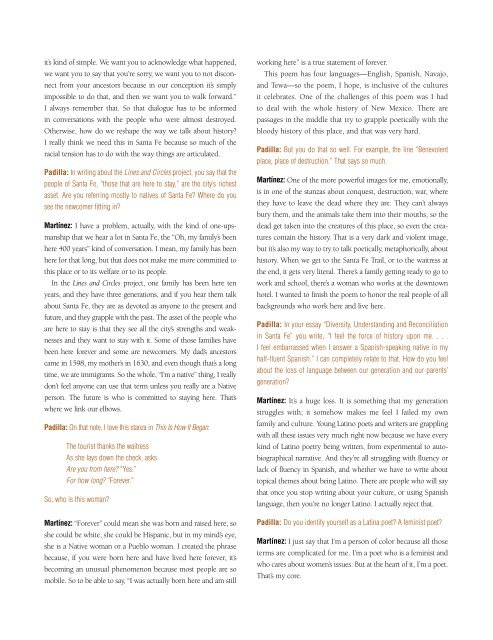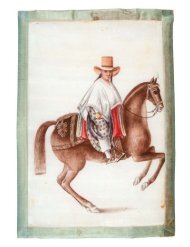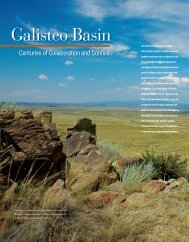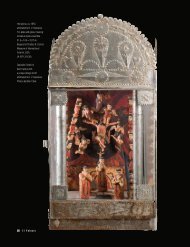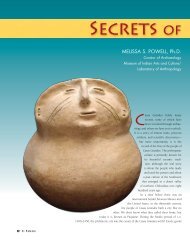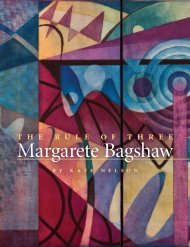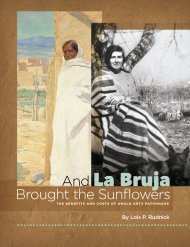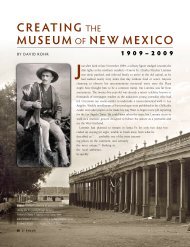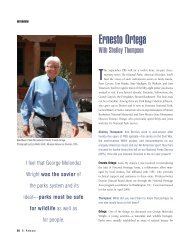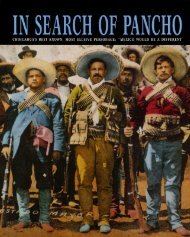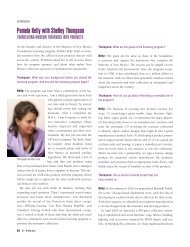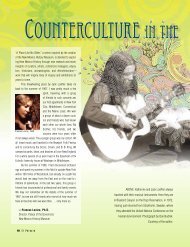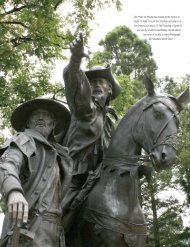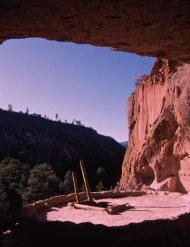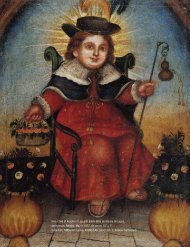Valerie Martínez - El Palacio Magazine
Valerie Martínez - El Palacio Magazine
Valerie Martínez - El Palacio Magazine
You also want an ePaper? Increase the reach of your titles
YUMPU automatically turns print PDFs into web optimized ePapers that Google loves.
it’s kind of simple. We want you to acknowledge what happened,<br />
we want you to say that you’re sorry, we want you to not disconnect<br />
from your ancestors because in our conception it’s simply<br />
impossible to do that, and then we want you to walk forward.”<br />
I always remember that. So that dialogue has to be informed<br />
in conversations with the people who were almost destroyed.<br />
Otherwise, how do we reshape the way we talk about history?<br />
I really think we need this in Santa Fe because so much of the<br />
racial tension has to do with the way things are articulated.<br />
Padilla: In writing about the Lines and Circles project, you say that the<br />
people of Santa Fe, “those that are here to stay,” are the city’s richest<br />
asset. Are you referring mostly to natives of Santa Fe? Where do you<br />
see the newcomer fitting in?<br />
<strong>Martínez</strong>: I have a problem, actually, with the kind of one-upsmanship<br />
that we hear a lot in Santa Fe, the “Oh, my family’s been<br />
here 400 years” kind of conversation. I mean, my family has been<br />
here for that long, but that does not make me more committed to<br />
this place or to its welfare or to its people.<br />
In the Lines and Circles project, one family has been here ten<br />
years, and they have three generations, and if you hear them talk<br />
about Santa Fe, they are as devoted as anyone to the present and<br />
future, and they grapple with the past. The asset of the people who<br />
are here to stay is that they see all the city’s strengths and weaknesses<br />
and they want to stay with it. Some of those families have<br />
been here forever and some are newcomers. My dad’s ancestors<br />
came in 1598, my mother’s in 1630, and even though that’s a long<br />
time, we are immigrants. So the whole, “I’m a native” thing, I really<br />
don’t feel anyone can use that term unless you really are a Native<br />
person. The future is who is committed to staying here. That’s<br />
where we link our elbows.<br />
Padilla: On that note, I love this stanza in This Is How It Began:<br />
The tourist thanks the waitress<br />
As she lays down the check, asks<br />
Are you from here? “Yes.”<br />
For how long? “Forever.”<br />
So, who is this woman?<br />
<strong>Martínez</strong>: “Forever” could mean she was born and raised here, so<br />
she could be white, she could be Hispanic, but in my mind’s eye,<br />
she is a Native woman or a Pueblo woman. I created the phrase<br />
because, if you were born here and have lived here forever, it’s<br />
becoming an unusual phenomenon because most people are so<br />
mobile. So to be able to say, “I was actually born here and am still<br />
working here” is a true statement of forever.<br />
This poem has four languages—English, Spanish, Navajo,<br />
and Tewa—so the poem, I hope, is inclusive of the cultures<br />
it celebrates. One of the challenges of this poem was I had<br />
to deal with the whole history of New Mexico. There are<br />
passages in the middle that try to grapple poetically with the<br />
bloody history of this place, and that was very hard.<br />
Padilla: But you do that so well. For example, the line “Benevolent<br />
place, place of destruction.” That says so much.<br />
<strong>Martínez</strong>: One of the more powerful images for me, emotionally,<br />
is in one of the stanzas about conquest, destruction, war, where<br />
they have to leave the dead where they are. They can’t always<br />
bury them, and the animals take them into their mouths, so the<br />
dead get taken into the creatures of this place, so even the creatures<br />
contain the history. That is a very dark and violent image,<br />
but it’s also my way to try to talk poetically, metaphorically, about<br />
history. When we get to the Santa Fe Trail, or to the waitress at<br />
the end, it gets very literal. There’s a family getting ready to go to<br />
work and school, there’s a woman who works at the downtown<br />
hotel. I wanted to finish the poem to honor the real people of all<br />
backgrounds who work here and live here.<br />
Padilla: In your essay “Diversity, Understanding and Reconciliation<br />
in Santa Fe” you write, “I feel the force of history upon me. . . .<br />
I feel embarrassed when I answer a Spanish-speaking native in my<br />
half-fluent Spanish.” I can completely relate to that. How do you feel<br />
about the loss of language between our generation and our parents’<br />
generation?<br />
<strong>Martínez</strong>: It’s a huge loss. It is something that my generation<br />
struggles with; it somehow makes me feel I failed my own<br />
family and culture. Young Latino poets and writers are grappling<br />
with all these issues very much right now because we have every<br />
kind of Latino poetry being written, from experimental to autobiographical<br />
narrative. And they’re all struggling with fluency or<br />
lack of fluency in Spanish, and whether we have to write about<br />
topical themes about being Latino. There are people who will say<br />
that once you stop writing about your culture, or using Spanish<br />
language, then you’re no longer Latino. I actually reject that.<br />
Padilla: Do you identify yourself as a Latina poet? A feminist poet?<br />
<strong>Martínez</strong>: I just say that I’m a person of color because all those<br />
terms are complicated for me. I’m a poet who is a feminist and<br />
who cares about women’s issues. But at the heart of it, I’m a poet.<br />
That’s my core.


